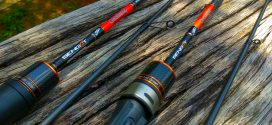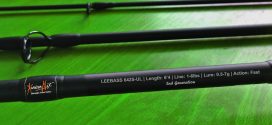“My rod (6-12lbs – 5.4kg) broken when I lifted the fish from water how come? The fish not even 2kg”. A friend asked me…
This is facts not a myth.
Line rating (poundage) given to the rod does not indicate how much weight your fish can take. The rating is given as a guide to choose the line classification power that can be used for a rod with the appropriate drag for the selected line. The rating is designed to achieve the working curve level on the rod without exceeding the maximum lock-up point acceptable to a rod.
Majority of anglers will say you don’t have to follow ratings given on the rods because they know how to adjust the drag to suit the rod. No right and wrong here. It’s up to individual understanding. But in reality, this kind of thinking is the main cause why rod breaks and the reason why many failed to understand they are not enjoying the rod performance completely because they just want fish to brag.
What is the Rod Major Task?
For further explanation rod should is designed to achieve two main tasks namely:
1. The rod first main task is to act as a shock absorber. Where the rod should bent when there is impact and flex back when the fish try to escape or jump. This shock absorption helps to hold your hook from bend/broken or helps in avoiding the line from breaking.
2. The rod second task is to give a small lifting power. This is said the bending action where the curved rod will return at its origin position; straight where it helps the angler in making a hook up and also gives them ability to enjoy the lure action in the manner they want. The lock-up point is the border at which the rod cannot exceed the danger point that will cause the rod to break.
And that’s why balance and matching is important when choosing your fishing setup especially when it comes to ultralight fishing. We need to get it right not only to avoid problems but to maximize the performance with the chosen setup. But do take note balance and matching not only with your setup but also with your techniques, fishing style, fishing spots, target fish, lure weights, and many other factors that will affect the whole things.
Rod Ratings
Ratings on the rod definitely means something. It allow you to at least understand the rod capability. Rod in Europe/US market normally comes with common rating system compare to some other countries. Normally the ratings will use 2 rating line the “low” and “high”. Example: 2-6lbs, 4-10lbs, 8-17lbs and so on. While in Japan they prefer PE ratings.
Ratings on the rod show reference on maximum bending the rod can accept until it reach to lock-up point. In many cases the “high” rod poundage is not recommended for fishing. Example: Rod 2-6lbs; 6lbs is not recommended for fishing because that is the lock-up point (danger zone) for the rod.
This is the advantages of getting a rod labeled the “low” and “high”. It gives you better reference on what your rod can do and can’t. At the same time you are guided on how to get the maximum satisfaction when choosing the right reel, lines, lures and other accessories.
Rods are given poundage for some purpose and for what the rod is made. Normally, it will be tested with lifting power using proper computerized tools. The strength, action, rod power need to properly consider to suit their targeted fish and targeted market (user). We are not using same rod for all type of fish. Other factors that also affecting the rod strength is wrapping technology (like 3k, 2k, 1k, Spiral, X-wrap, K-wrap, etc.) that being used. And that’s the main reason why there are differences in brands even with the same poundage because every one of them has ways and protocols to follow when producing a rod. They have their own carbon fiber technology, resin and mixing secrets that make their rods stands out than others. It’s all about quality in the end.
Anyway, we are end user; normally only being feed with relevant info that we could understand and its better to focus on fishing and suit the game properly.
How To Test?
There are few ways to test the line breaking strain on the rod. Not 100% perfect but can be used as reference and knowledge purpose.
Method 1:
You can test using various lines. Fix the line on your reel like you normally go fishing and tie the line with digital scale. Pull the scale until the rod bending reach the maximum lock-up point that suit with the rod action. Check your scale, take the reading and it will give you some idea your maximum drag setting that you can use for the rod.
The rule of thumb for a reel drag is 25% of the maximum line breaking strain. So, in this case you divide by 4 of the rod bending. Example: If your drag is 6kg then if you divide by 4; the best drag setting is 1.5kg and in this example we use 6lbs main line. But for experienced anglers it’s still safer to use anything between 4-6lbs.
Take note: What we did here is just estimation (knowledge basically) for reference purposes that give you some idea what you can and safer to use/do. Most important it can assist you in making some good decision rather than taking unnecessary risks.
Read drag setting for ultralight, for more info.
Method 2:
Another method you can use as reference is the lure weights written on the rod. You can use them to estimate the rod poundage.
Example 1: Rod poundage 1-6lbs
Meaning you can cast lure weight from 1 gram to 6 gram easily without any extra force/efforts. Some rods can accept plus 1 gram extra lure weight. In this case you can use to cast up to 7g max. Anything above that it will bring harm to the rod. It’s better not to exceed and just follow what is recommended.
Example 2: Rod poundage 1-4lbs
You can cast easily lure weights from 1 gram to 4 gram and some rods allow you to cast up to 5 gram.
If happen you unable to cast 1 gram to 4 gram easily meaning something is not right with the setup. There could be few reasons like your chosen setup i.e. line and reel is not well-balanced and matching with the rod or the rod maybe not labeled at the right poundage. If this happened you can try on few weights until you get the best lure weight that suits the rod.
Example 3: Lure weight 0.7g – 6g but labeled as 1-3lbs
From lure weight this rod can be either 1-5lbs or 1-6lbs or anything lower to max of 6lbs. Some rods (Ajing / Mebaru / LRF) have good tip flexibility force to cast lure weights like 1 gram or lower. But to allow 6 gram on 3lbs rod is not common because it exceeded allowed common practice of lure weights.
You can do your own research on this with various ultralight fishing rods and try to analyze it. You may find good brand rods normally followed the basic understanding on lure weights against the rod poundage. Again this whole example is just estimation you can use for your own reference/research. Technologies may exist to counter what we have discussed here but no way we end user able to prove it.
Rod Sensitivity
So, the next time you buying a rod make sure you take time and understand the specifications given on the rod. Take it as one of the decision factor for the game you want to use it for. The level of rod sensitivity depends on the lowest/lightest lure weights the rod can cast. If it’s say 6g maximum lure then you can guess this rod is meant for bass game type or anything similar. Best line to use normally around maxima 5lbs or 6lbs max depending on your lures selection. If the lure weight recommended exceeding 6 gram than the rod should have less sensitivity and hard.
If the rod is labeled anything between 0.5g to 1g lure weights then this rod should be very sensitive. But remember not all rods today follow the specification. Today world it’s all about money so lots of unethical things going on behind. Lots of sticking fancy label behind for the sake of fulfilling current trend and demand. Especially most rods sold below RM150 (below $30) which you can find easily on market place. Just do your own calculations how can a manufacturer producing rods for that price? It doesn’t make sense at all. Quality / Sensitivity = Not Cheap. It could be some blanks left-over in factory for years and they just take, labeled it and sell for the market that buy cheap products. At least all these are not wasted.
And that’s why most top brands spending lots of efforts on technology research, field-testing, money and time to produce quality and sensitive rods. And that’s why their rods price can burden pockets because they put their knowledge and commitment to satisfy anglers. Therefore, branded rods are usually more expensive and the quality is far better than cheap rods because they are not OEM or re-brand.
Good brand always spend time to do R&D and produce the best rods.
Stop Comparing
Stop comparing brands and quality because expensive rods normally way far than cheap rods. Not saying don’t use cheap rod but just stop comparing since it doesn’t go along. You can’t compare rods because each one of them using different technology. You will never understand the rod technology since they will never reveal it. It’s their secrets how can they reveal. Think about it. Usually you will be provided with info that you can only understand example like accessories, blank technology, guides and so on. The fact is good R&D rods always go further.
Do not compare car like Proton Kancil and Ferrari because both are made for different purposes, technologies and budgets.
Note: Make sure you understand the intention of this article; provided info for the purpose of education.
Conclusion
Ratings are given for rods because for us to use as guidance in selecting proper setup/accessories to make sure it’s well-balanced and matching to obtain maximum performance. It’s also to serve as a guide for you not to exceed it because it may damage the rod.
Ultralight game is an art. The rod engineer took plenty of time to produce one finest and high sensitivity rod. The blank is very thin to suit the purpose it was created and it can’t absorb additional force or impact than what is suggested.
Be a wise angler and use “balance and matching” if you choose to enjoy ultralight fishing. This is because the true fun will only come when you able to feel the rod vibrate even a small bite.
Throughout my life as an angler only 3 times I’ve broken the rods and every broken rod is because I force the rod by not maintaining balance and matching when we conducting on-field testing. During this phase we will force the rod without restrictions for R&D purposes. But never once did my rod break if balance and matching serve as a principle.
Normally, if the rod got problem it will break after one two times use. But if you have used the rod for a period of a week or a month two and broke it; then it is not the rod but your own mistakes; handling issues. Perhaps your rod is stored in an incorrect manner, left in the car, lures knocking the blank, and many other reasons. Or the most common problem that almost every angler does is not applying balance and matching principle.
Rarely rod is broken due to following the specs; only if you ignore the recommendation then nothing is impossible.
You can read article below why rods broken:
https://www.ultralightanglers.com/kenapa-rod-ultralight-mudah-patah/
Note:
All information given is based on best efforts to express our opinions and knowledge that has been acquired. Paragraph or inappropriate words may have been used and it is out of control because we have tried most wisely. If you have suggestions, please comment. We will make changes.
Hey guys! You can call me Kanicen and I’m a nature lover. I spend most of my time outdoor with fishing. I have to admit that I am not an expert but I will do my best to share with you interesting stuffs I know. I love ultralight game which means I live to challenge myself with UNREALISTIC LOGIC for satisfaction.
 Ultralight Fishing Tips and Tricks For Ultralight Anglers Ultralight Trend Setter
Ultralight Fishing Tips and Tricks For Ultralight Anglers Ultralight Trend Setter








Hi,
Am interested in buying your products. How can I purchase your products online?
Hi there,
thanks for the comment and interested in our products. You may contact us at:
https://web.facebook.com/kanicennixmalaysia/
thank you 🙂